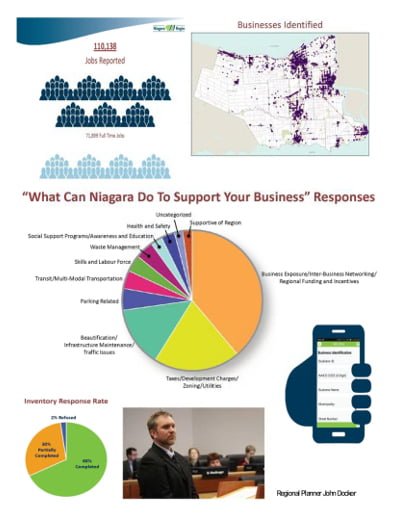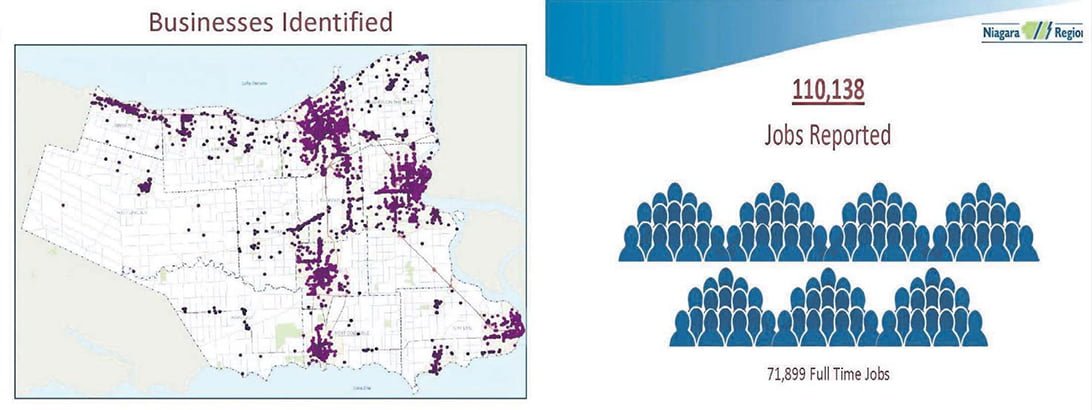 It may not have an exciting title — the Niagara Region Employment Inventory — but the innovative new study may prove to be a treasure trove of data for local businesses and potential investors.
It may not have an exciting title — the Niagara Region Employment Inventory — but the innovative new study may prove to be a treasure trove of data for local businesses and potential investors.
Niagara Region’s planning department tackled the process of creating a detailed “inventory” of all area employers and employees over the summer. The department’s John Docker said the results are better than expected.
The survey is the first of its kind for Niagara.
The data could ultimately be used to help spur growth and attract investment.
“We are trying to build nuts-and-bolts employment information,” Docker said. “We are sharing it with our local municipalities, the workforce planning board and the local Ontario employment agencies.
“We are building this for people to use. It won’t be long before we make it available publicly. We will have to modify the attributes, but data needs to be in the hands of people. It doesn’t do us any good to keep it under lock and key up here.”
The survey was completed in the summer, Docker told the Region’s planning and development committee last week in a bid for continued funding.
University students conducted face-to-face interviews with business owners and compiled the information on mobile devices.
The statistics include general business characteristics, employee counts and industry classifications. As the database is improved and, updated, it will help in analyzing trends and year-to-year changes.
“We should do this every year,” said Tim Reynolds, a manager with Niagara Region Economic Development. “We need the primary data from an employment survey. It arms us for the competition ahead.”
Students visited 11,000 visible businesses and mapped the location of about 110,000 jobs. Only about 200 companies refused to participate.
Regional staff then added to the information with outside sources — such as census data — to complete the picture.
Mishka Balsom, president and CEO of Greater Niagara Chamber of Commerce, said the business community welcomes this kind of aggregation of information.
“It is critical that we have the data to compare with other regions in Ontario,” she said. “The information will give us a competitive advantage when we talk to potential investors and businesses.
“We also need to keep following it up, so the data is consistent. That allows us to define where the clusters are, the movement within those clusters and the shifts in various sectors. Asset mapping and a continuous supply of data help in a number of different ways.”
Docker explained that part of the problem with surveys is getting people to participate.
Fresh-faced and enthusiastic students visiting the businesses in apparel branded with the Region’s logo kickstarted the process.
“We used a very traditional model, but we took a very innovative approach in collecting it,” Docker said. “We used Cloud-based technology. We used Samsung Galaxy phones as opposed to tablets.
“Primary data is where it’s at, but it isn’t an easy process to undertake. You need some strong checks and balances and a good process. The trends are a huge value in a project like this.”
The process also helps build rapport with businesses and regional government. The students concluded by asking for feedback on the question “What can Niagara do to support your business?”
The three top answers were business exposure, networking and incentives; taxes, development charges, zoning and utilities; and, beautification, infrastructure maintenance and traffic issues.
The initiative cost about $92,000 with most going to student wages and mileage. The hardware cost $2,000. Cellular fees were $1,500.
“We had some amazing students,” Docker said. “It was a lean team, and students were out of this world.
“We made deployment maps, and said to them, ‘Get out there and discover.’ Everything you see with a sign, do an inventory from the street and then approach the business owner.
“Tracking the number of employees is huge for us from a planning perspective. We need to know on the ground where folks are working.
“So many of our services are dependent on it. We are thrilled with what we achieved in Year 1. Now, we want to strengthen the brand and get people to buy in and see the value. We want the number at 100 per cent.”
Another first for Niagara was using geographic markers for the data. That will also allow the Region to track the movement of businesses and will provide municipalities, as well as investors, insight into the development opportunities available within Niagara.
Original article: http://www.stcatharinesstandard.ca/2017/02/07/time-to-take-inventory



